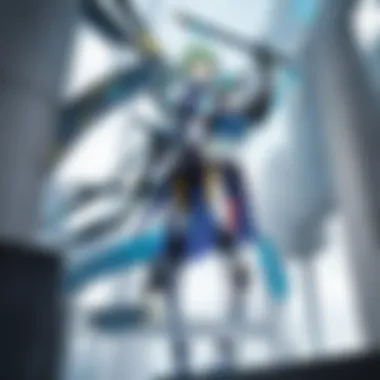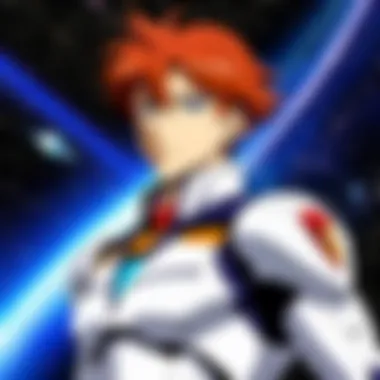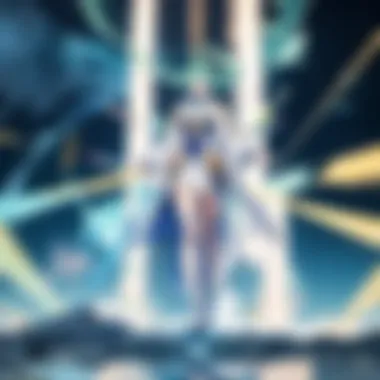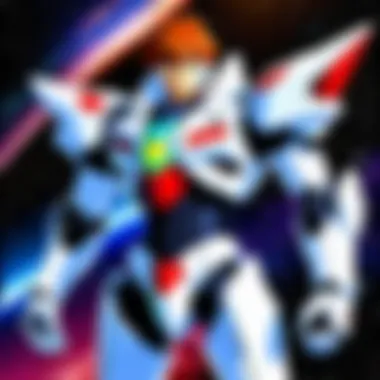A Comprehensive Exploration of Aquarion Anime


Intro
Aquarion, a name that resonates in the anime community, offers a unique blend of science fiction and drama that captivates viewers. This series, created by Shoji Kawamori, is known for its intricate narrative and thematic depth. The animation debuted in the early 2000s, quickly becoming a notable entry within the mecha genre.
Located at the intersection of futuristic technology and human emotion, Aquarion explores themes such as love, destiny, and the battle against overwhelming odds. The choreography of transforming mechas and complex character arcs adds layers to its storytelling. Understanding Aquarion involves delving into its plot intricacies, character motivations, and artistic presentations, all of which have contributed to its standing in contemporary anime discussions.
In this comprehensive exploration, we will dissect various elements. These include the intimate character relationships, the philosophical inquiries posed by the series, and its cultural impact within the anime landscape. Our analysis aims to provide a deeper appreciation for Aquarion, examining not only the surface-level entertainment but the undercurrents that drive its narrative and thematic core.
Preamble to Aquarion Anime
Understanding Aquarion Anime is essential for grasping its profound impact on the anime landscape. This section lays the groundwork for the remainder of the article, offering insight into what makes this series unique and notable. Aquarion stands out due to its complex narrative, artistic design, and significant cultural underpinnings.
Overview of the Series
Aquarion Anime first premiered in 2005, created by the renowned studio Satelight. The series is set in a post-apocalyptic world where humans battle against monstrous beings called 'Shadow Angels.' These beings are propelled by their desire to conquer humanity. The story follows a group of pilots who control a giant mecha called Aquarion, fighting these foes to protect their loved ones and reclaim a lost paradise. The plot intertwines themes of love, sacrifice, and the struggle for identity, making it relatable on various levels.
From its inception, the series has garnered a dedicated fan base, partly due to its engaging characters and rich storyline. Each protagonist grapples with personal dilemmas while striving for a higher cause. The combination of science fiction, romance, and psychological elements creates a unique viewing experience.
Cultural Context and Significance
Aquarion holds a crucial position within the broader anime culture. Its blend of genres reflects the evolving tastes of anime audiences in the mid-2000s. The series addresses themes like reincarnation and the transcendence of love across different lifetimes, resonating with the increasingly philosophical narratives in contemporary media.
Moreover, the show's mythology draws inspiration from various cultural and religious concepts. This depth of intertextuality enhances its significance as more than just entertainment. The series serves as a mirror reflecting the complexities of human emotions and relationships, making it a compelling study for both fans and scholars.
In many regards, Aquarion contributes to ongoing discussions about identity, technology, and human connection. As fans engage with these themes, they find relevance that transcends the screen. \n
"Aquarion's depth lies not only in its gorgeous visuals but also in its rich thematic explorations that invite reflection on the human condition."
This narrative reveals why Aquarion is not merely a mecha anime, but a richly layered series worthy of analysis. Understanding its elements is key to appreciating its legacy within anime history and culture.
Historical Background
The historical background of Aquarion serves as a crucial foundation for understanding its narrative and cultural significance. Delving into the origins and production timeline reveals not only the creative impetus behind the series but also its evolution within the larger context of anime history. This section aims to provide insights into how Aquarion was born, the influences that shaped its creation, and the broader trends in anime during its inception, thus enriching the viewer's experience and appreciation.
Origin of Aquarion
The origins of Aquarion can be traced back to the mind of the renowned anime director, Shoji Kawamori. He is also known for his work on Macross. The conceptualization of Aquarion began in the early 2000s, with the need to explore themes of love and conflict within a science fiction framework. The series debuted in 2005, produced by Gonzo, famous for its unique approaches to storytelling and animation.
The idea behind Aquarion is deeply embedded in the concept of merging disparate elements—these vary from mechanical designs to character relationships. This series was created to address how love can transcend time and the reincarnation theme, with a particular focus on the struggle against an ancient foe known as the Dereon. The blending of these thematic elements strengthens the narrative.
Production Timeline
The production timeline of Aquarion offers a glimpse into the challenges and processes behind its creation. The series first aired in April 2005 and ran until September of the same year, comprising 26 episodes. Throughout this period, the production team focused heavily on crafting a rich story while also ensuring that the animation quality stood out.
Notably, the series integrated various animation techniques and technologies of the time, which contributed to its visual appeal. To give more insight through dates:
- 2005: Premiere of Aquarion, initiated its presence in the anime community.
- 2007: A sequel, Aquarion Evol, was subsequently announced, highlighting the significant impact and popularity of the original series.
- 2011: A theater adaptation and merchandise rolled out, indicating the franchise’s expansion beyond television.
In reviewing this timeline, it is evident that Aquarion has maintained relevance in the anime landscape through continued exploration of its key themes. The successful blend of character arcs, aesthetic choices, and the evolutionary storyline showcases the series' foundation and impact, making it a significant part of anime culture.


Narrative Structure
The narrative structure of a story serves as the backbone, guiding the flow of the plot and the development of its themes. In the context of Aquarion, the narrative is particularly significant as it intertwines elements of science fiction, romance, and mythology. This layered storytelling allows for a complex exploration of its characters and themes, which contributes to its lasting impact on the anime community.
The structure influences how audiences perceive the progression of events and character developments throughout the series. By dissecting the plot and its thematic elements, we can appreciate how the Aquarion series constructs tension, character arcs, and resolution, leading to a multifaceted experience for viewers.
Plot Summary
The vast universe of Aquarion unfolds in a future world where humanity faces a persistent threat from the shadowy Chaos. To combat this menace, three individuals, Teo, Silvia, and Zessica unite in a giant mecha known as Aquarion. Each character possesses distinct backgrounds and motivations that are revealed throughout the series. As they battle against various adversaries, layers of personal conflict emerge, showcasing their growth in defining moments of adversity.
The primary plot revolves around the struggle between light and darkness, representing the characters' internal battles against their own fears and desires. As the narrative progresses, the connections between the characters deepen, revealing themes of love and sacrifice, bringing both pain and resolution. The climax presents a juxtaposition of personal stakes against a backdrop of sprawling mecha battles, ultimately asking the audience to consider what it means to fight for a greater cause.
Themes and Motifs
Aquarion does not shy away from exploring profound themes and motifs throughout its narrative. Here are some key elements:
- Reincarnation and Fate: The series frequently delves into the concepts of reincarnation and predestination, suggesting that the souls of the main characters are tied across time.
- Love and Connection: Romantic connections drive many character motivations, highlighting both the beauty and pain that comes with love.
- Redemption: Several characters grapple with their pasts, seeking redemption through their actions, reflecting a universal struggle.
- Sacrifice: The notion of sacrifice recurs, as characters often must make difficult choices for the greater good.
These themes resonate deeply within the framework of the narrative, allowing Aquarion to elevate itself beyond traditional mecha anime. Each story arc brings another layer of complexity, ultimately contributing to a rich tapestry that invites various interpretations.
"Aquarion’s narrative intricacy offers viewers both entertainment and a philosophical inquiry into the nature of existence and emotional connection."
Through this detailed examination of narrative structure, plot summary, and thematic depth, readers gain insight into how Aquarion functions not only as an animated series but also as a source of critical dialogue in the realm of anime.
Character Analysis
In any anime series, characters form the backbone of the narrative. In the case of Aquarion, the character design and development play a significant role in how the story unfolds. Analyzing the characters provides insights into their motivations, relationships, and growth throughout the series. The connections between characters are not only essential for plot progression but also enrich the emotional depth of the viewing experience. Through character analysis, fans can appreciate the craftsmanship behind the writing and the complexities that define the series.
Protagonists and Antagonists
Aquarion features a diverse cast, where protagonists and antagonists are vividly crafted. The main characters, such as Apollo, Sylvie, and Zessica, embody the core themes of the series: hope, love, and the battle between light and darkness. Each character is distinct, yet they share a common goal, making their interactions vital for the story. Their struggles and triumphs resonate with the audience and enhance the relatability of the narrative.
On the other hand, antagonists, like Balban and Nicol, provide crucial conflict. Their motives often mirror those of the protagonists, creating a complex interplay of ideals. The character backgrounds are fleshed out, allowing viewers to empathize, even with those on the opposing side. This duality contributes to a multi-faceted narrative where moral ambiguity becomes a key feature.
Supporting Characters
Support characters in Aquarion, such as Rein and Mugen, are not just secondary figures. They enhance the main narrative and provide depth to the protagonists’ journeys. For instance, Rein's unwavering loyalty to Apollo serves as an anchor in the tumultuous plot of the series. These characters often reflect the main themes, creating a well-rounded storyline that is both engaging and thoughtful. The moments they share with protagonists highlight critical aspects of friendship, sacrifice, and personal growth.
"Support characters propel the main characters towards growth while bringing their unique perspectives into the mix."
Character Development Arcs
The character development arcs in Aquarion are meticulously plotted. Each primary character goes through significant transitions, shaped by the events they encounter. Apollo, initially uncertain and naïve, evolves into a figure of strength and leadership. Sylvie’s journey examines love, loss, and acceptance, revealing her layered persona. These arcs are not just about external challenges; they also delve into internal struggles, making them relatable and poignant.
As they progress, the characters’ motivations evolve, often leading to climactic moments that challenge their beliefs and alliances. This growth is shown through significant events that test their resolve, relationships, and values. By the end of the series, the transformations are evident, leaving a lasting impact on both the characters and the viewers.
Visual Aesthetics
Visual aesthetics play a crucial role in defining the unique identity of Aquarion. This anime is not just a feast for the eyes but also serves as a vital storytelling component. Through its animation style, character design, and environmental artistry, Aquarion invites viewers into its universe, creating a compelling atmosphere that underpins its narrative.


Animation Style
The animation style of Aquarion reflects both fluidity and dynamism, essential for conveying the action sequences that tooke center stage. The combination of traditional hand-drawn techniques with modern digital effects is noteworthy. Characters often exhibit a high degree of emotional expressiveness through exaggerated movements and stylistic choices that enhance their individuality.
Each transformation scene, for instance, showcases intricate designs and slick transitions, pulling the viewer further into the action. This level of detail ensures that audiences remain visually captivated, enhancing their connection to the story's heroes and villains. In this context, movement is not merely functional but also an art form that elevates the overall viewing experience.
Character Design
Character design is another integral aspect of Aquarion's visual narrative. The creators have paid close attention to the distinct features of each character, ensuring their appearances align with their personalities and arcs. From the sharp angles of the villains to the softer, rounder features of the protagonists, every design choice contributes to character identification.
The color palette also plays a significant role. Bright colors are often employed for heroes to signify hope and determination, while darker tones are used for antagonists to evoke a sense of foreboding. As a result, viewers can easily relate to or dislike characters based on visual cues alone, making character design not just aesthetics but a pivotal storytelling tool.
Environmental Artistry
The environmental artistry in Aquarion is noteworthy for its ability to create immersive world-building. Landscapes and settings are meticulously crafted, showcasing a blend of futuristic and organic designs. Each environment reflects the emotional tone of the narrative, from serene natural backdrops during introspective moments to chaotic urban settings during battles.
These environments do not merely exist as backdrops; they engage with the characters' journeys. The locations often mirror the internal states of the protagonists, serving as a visual metaphor that enriches the audience's understanding of the story's themes. The attention to detail in designing these worlds heightens the viewer's enjoyment. The artistry becomes a conduit for deeper connections with the narrative.
In Aquarion, visual aesthetics are not just ornamentation but fundamental elements of storytelling that enhance emotional engagement and character development.
Overall, Aquarion stands out due to its visual aesthetics that blend animation style, character design, and environmental artistry. These elements together create a rich tapestry that adds depth to the series and invites exploration beyond the surface.
Soundtrack and Audio Design
In the realm of anime, soundtrack and audio design play a pivotal role in shaping the viewer's experience. These elements not only enhance the emotional depth of a series but also add layers to character development and plot progression. In Aquarion anime, the integration of music and sound is particularly significant, as it underscores the series’ thematic richness and helps convey complex narratives. The importance of sound in this anime cannot be understated; it is a critical component that interacts with the visual storytelling, elevating the overall impact on the audience.
Musical Score
The musical score of Aquarion, composed by Yoko Kanno, presents a captivating blend of orchestral arrangements that resonates deeply with the series’ themes. Each musical piece is crafted to evoke specific emotions, reflecting the characters' struggles and triumphs. Kanno’s adeptness at creating memorable motifs for different characters enhances their personality.
The score features several key aspects:
- Variety of Genres: The score includes elements of pop, classical, and even choral music, which allows it to appeal to a wide audience.
- Emotional Resonance: Many compositions are designed to amplify the emotional stakes of critical scenes, making the viewer feel a deeper connection to the storyline. For instance, during moments of conflict, the music escalates, enhancing the tension.
- Integration with Narrative: Music is used strategically to reflect the narrative arc. This harmonious blend not only sets the tone but also foreshadows plot developments.
Fans often highlight specific tracks, stating that they recall key moments from the series, illustrating the music's enduring impact. Such musical elements do not merely accompany the action; they are integral to the storytelling itself.
Voice Acting Performance
The voice acting performance in Aquarion adds another dimension to character portrayal. The selection of voice actors contributes significantly to the series' overall quality, as their performances convey the emotional depth and nuances of the characters effectively. Professional actors like Yūichi Nakamura, who voices the protagonist, deliver performances that capture the essence of their characters.
Several factors underscore the importance of voice acting:
- Character Authenticity: The actors breathe life into their roles, providing unique interpretations that resonate with viewers. This authenticity allows audience members to relate to each character on a personal level.
- Dramatic Range: The ability of voice actors to express a range of emotions, from joy to despair, is vital. The high-stakes situations depicted in the anime require actors who can effectively convey these complexities through their vocal delivery.
- Cultural Context: Given that Aquarion roots in Japanese culture, the voice performances often encapsulate cultural nuances that might be lost in translation. This adds layers of depth, enriching the viewing experience for audiences globally.
"The voice acting in Aquarion not only brings the characters to life but also shapes the audience's understanding of the storyline and its emotional intricacies."
In summary, both the musical score and voice acting performance are essential to the storytelling of Aquarion. They work in tandem to create a more immersive experience, illustrating how sound and voice can significantly influence the perception and enjoyment of anime.
Impact on Anime Culture


Aquarion has carved a noteworthy niche within anime culture, which can be seen through its unique storytelling and thematic depth. The series not only entertains but also provokes thought, inviting audiences to engage with complex issues that resonate within the human experience. This section examines how Aquarion has influenced fans and other creators in various ways.
Fan Reception
The reception of Aquarion among fans has been overwhelmingly positive, contributing to its enduring status in the anime community. When it first aired, the series garnered a significant following, with its blend of mecha action, romance, and intricate plotlines appealing to a wide audience. Fans have praised its emotional depth, particularly in how it addresses themes of love, sacrifice, and the struggle against fate.
"The mix of action and emotional storytelling in Aquarion creates a unique experience that many find compelling."
Social media platforms, such as Reddit and Facebook, have played a vital role in facilitating discussions about the show. Fans share their thoughts on character development, plot twists, and overarching themes. Moreover, cosplay and fan art inspired by the characters have flourished, showcasing the series' impact on creative expression.
Influence on Other Works
Aquarion's influence extends beyond its own narrative and characters, impacting various subsequent works in the anime industry. Many creators take inspiration from Aquarion’s intricate plots and character dynamics, showcasing how a well-developed story can enhance a series. For instance, narrative techniques used in Aquarion, such as the multi-layered storytelling and character interconnections, can be seen echoed in series like Guilty Crown and Kyoukai no Kanata.
Additionally, the thematic focus on love versus duty in Aquarion has become a motif that several newer anime explore. The storytelling methods used pave the way for characters with richer backstories and motivations, something that resonates well with modern audiences. Notably, the iconic mecha design has influenced art styles in other franchises, reinforcing how Aquarion has shaped visual aesthetics in anime.
In summary, Aquarion’s impact on anime culture is multifaceted. Its reception among fans has cemented its importance, while its influence upon newer anime demonstrates how powerful narratives can leave a lasting legacy.
Aquarion Legacy
The legacy of Aquarion is significant and multifaceted. This series has not only captured the attention of anime enthusiasts but has also established a long-lasting impact on the genre itself. It serves as a pivotal reference point for discussions surrounding mecha anime and character-driven stories. The thematic depth and unique narrative style have encouraged a dedicated fanbase, allowing the franchise to extend beyond its initial release.
Franchise Expansions
Aquarion has seen remarkable expansions since its debut. This includes various sequels, spin-offs, and adaptations that further explore its universe. Notably, Aquarion Evol, which aired in 2012, reintroduces elements from the original series while introducing new characters and narrative arcs that resonate with both old and new viewers.
In addition, there have been manga adaptations, art books, soundtracks, and even video games that have broadened the aquatic world. Each expansion adds layers to the existing lore and provides fans with enriching content. The rich visual storytelling is complemented by compelling audio scores, which enrich the overall Aquarion experience.
Moreover, collaborations and merchandise extend far beyond traditional media. Fan-made works and community projects foster ongoing engagement, keeping the Aquarion spirit alive. This demonstrates how a successful franchise does not merely conclude with a single series but thrives through diverse fandom landscapes.
Continued Relevance in Anime
The relevance of Aquarion in the contemporary anime landscape is apparent through various factors. It influenced contemporary works with its exploration of complex themes such as love, sacrifice, and the interplay of human relationships within fantastical settings. Many modern series reference or draw inspiration from Aquarion's unique storytelling methods.
"Aquarion has set a standard in merging deep emotional narratives with spectacular visuals, making it a benchmark for future productions."
Furthermore, the discussions about Aquarion on platforms like Reddit showcase its ongoing impact. Fans regularly debate character arcs, thematic elements, and even the philosophical implications presented in the series. This discourse contributes to an ever-expanding understanding of the series' significance in the genre. Additionally, conventions and anime festivals often celebrate Aquarion's work, inviting nostalgia while inspiring new analyses.
End
The conclusion serves as a critical synthesis of everything discussed about Aquarion anime. It brings together the complex threads of its narrative, character dynamics, and visual ingenuity. In this section, we highlight the significance of the series and its impact on both individual viewers and the anime industry as a whole. The nuances of these reflections invite readers to appreciate the depth of this work beyond mere entertainment.
Summary of Key Insights
Throughout the exploration of Aquarion, several key insights emerge:
- Narrative Complexity: The series weaves intricate storylines that challenge viewers' perceptions and expectations. Its handling of themes such as love, sacrifice, and conflict adds layers of meaning.
- Character Depth: Protagonists and antagonists alike are multidimensional, fostering a connection with the audience. The characterization invites empathy and reflection.
- Artistic Innovation: The animation style and character designs maintain a balance between uniqueness and aesthetic appeal, contributing to the series' visual identity.
- Cultural Resonance: Aquarion has left a mark on anime culture, influencing other works and fostering a dedicated fan base.
This summary encapsulates the groundwork laid throughout the article, emphasizing how Aquarion exceeds traditional storytelling boundaries.
Final Thoughts on Aquarion's Influence
Aquarion's influence on the anime landscape is both profound and enduring. By merging thoughtful storytelling with spectacular visuals and audio, it stands as a testament to what animated media can achieve. The series grapples with significant themes that resonate universally, thereby inviting interpretations that transcend cultural barriers.
Moreover, it has inspired creators and fans alike, grounding its legacy in ongoing discussions in the anime community. As tastes and styles evolve, the lessons learned from Aquarion will likely continue to inspire future generations of animators and storytellers, ensuring its relevance in the fast-paced world of anime.
This nuance enriched understanding of Aquarion reiterates its importance in today’s culture, affirming its status as a significant work in anime history.







